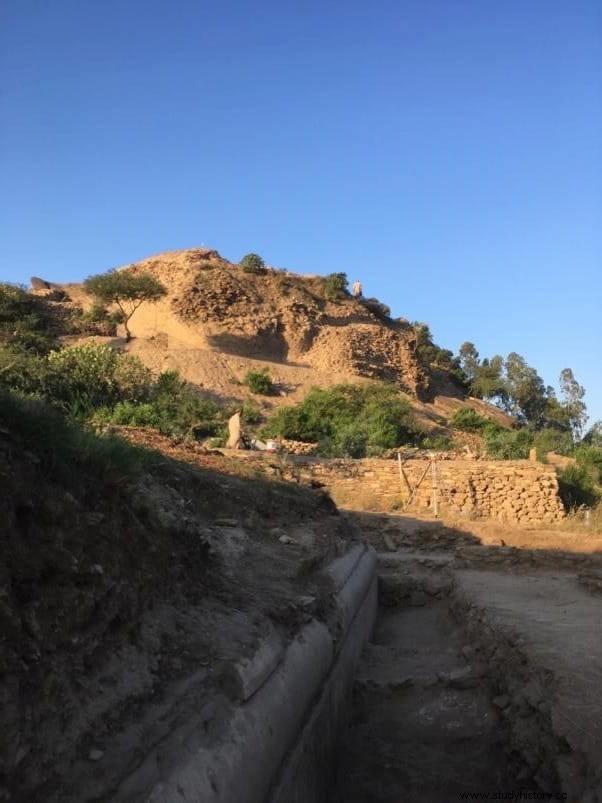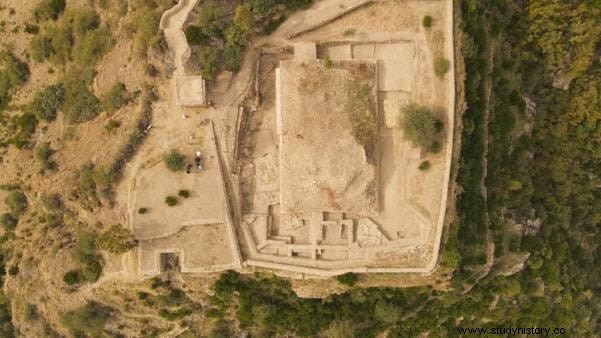One of the oldest Buddhist temples in the world has been discovered during the latest archaeological excavation campaign by the Italian mission in the city of Barikot, in the Pakistani region of Swat.
The finds date back to approximately the second half of the 2nd century BC, although they may be even older, dating back to the period of the Maurya empire (3rd century BC); only carbon 14 dating will provide stronger evidence. This discovery sheds new light on the forms of ancient Buddhism and its spread in ancient Gandhara, adding a piece to the puzzle of what we know about the ancient city.
The oldest Italian archaeological mission in Asia was started by Giuseppe Tucci in 1955 and is currently headed by Professor Luca Maria Olivieri of the Ca' Foscari University of Venice (Department of Asian and North African Studies). Since 2021, Ca' Foscari started a collaboration with ISMEO (the International Association for Mediterranean and Oriental Studies), jointly financed by the Italian Ministry of Foreign Affairs and International Cooperation and the Directorate of Archeology and Museums of the Province of KP (DOAM KP ) and the Swat Museum.

The discovery of a great religious monument created at the time of the Indo-Greek kingdom testifies that this was an important and ancient center of worship and pilgrimage. At that time, Swat was already a sacred land for Buddhism , says Professor Olivieri.
Barikot is mentioned in Greek and Latin texts as Bazira or Vajrasthana , one of the cities besieged by Alexander the Great, and the easternmost of the Greek fortresses. Archaeological stratigraphy excavated during the campaign and carbon-14 dated reveals that the city did, in fact, exist during the campaigns of Alexander the Great around 327 BC. Barikot was an important city for the management of all the agricultural surpluses of the Swat valley, which is special among the Karakoram-Hindu Kush valleys for its microclimate, which allows grain or rice to be harvested twice a year:once in spring and another at the end of the summer. The city was, therefore, a kind of barn that Alexander the Great used before continuing his campaign to India. The Roman historian Quintus Curtius Rufus highlighted the role Barikot played in describing it as a rich city (opulent urbs ) in his Histories of Alexander the Great (Historiae Alexandri Magni ).
The site of the excavations is impressive:located in a lush green valley at 800 meters above sea level, between the magnificent mountains of the Hindu Kush, it has a history that extends from the Bronze Age to the end of the Middle Ages. 
Barikot was continuously inhabited from Protohistory (1700 BC) to the Middle Ages (16th century AD) and houses more than 10 meters of archaeological stratigraphy. In October 2021, when the field work of the Italian Archaeological Mission ISEMO-Ca' Foscari in the city's acropolis was coming to an end, the archaeologists decided to explore a different place in the center of the ancient city, which had been plundered - as evidenced by a series of clandestine excavation trenches - on land recently acquired by the Pakistani archaeological authorities.
The archaeologists were in for a surprise:their work gradually uncovered a fascinating Buddhist monument that, despite having been repeatedly vandalized over the years, has been preserved. The temple is more than three meters high and has a particular structure and shape. It is built on an apsidal podium on which stands a cylindrical structure that houses a small stupa. It is clearly an example of Buddhist architecture. On the sides of the monument's façade there is a minor stupa, a cell and the podium of a monumental pillar or column. The staircase leading to the cell has been rebuilt in three phases, the most recent dating from the 2nd-3rd century AD, coeval with a series of vestibule rooms leading to a doorway opening onto a public courtyard leading to an ancient highway.
The oldest stairway in the monument featured half a step in situ with a dedicatory inscription in karosti script, which can be dated to the 1st century AD. for paleographic reasons. The other half of the ladder was found upside down, reused as a floor slab in the later phase of the monument. In addition, archaeologists found some coins in the lower strata, along with many ceramic inscriptions written in karosti script. The monument was abandoned in the early 3rd century AD, when the lower city was destroyed by an earthquake.

During the excavations, archaeologists discovered that the monument was built on the remains of an earlier structure flanked by a small archaic stupa that predates the Indo-Greek period, around 150 BC, during the reign of the Indo-Greek king Menander I or one of his early successors. According to Indian Buddhist tradition, Menander I converted to Buddhism. However, the site provided even more surprises for the archaeologists:in December 2021, a few days before the end of the mission, they observed that parts of the Indo-Greek monument had been built on top of an even older structure, whose strata included ceramic materials and terracotta figurines that were probably used in Barikot during the 4th and 3rd centuries BC
The chronology of the deposit will be confirmed by carbon-14 analysis, which will be very precise, given that during the excavations more than 10,000 liters of earth were moved and the team obtained 58 containers of semi-carbonated samples. At the end of the excavation campaign, in December 2021, 2,109 objects were documented and inventoried:ceramics, coins, inscriptions, stone and stucco sculptures, terracotta objects, seals and jewelry. The objects were entrusted to the new Swat Museum, in the capital of Saidu Sharif.

The Mission 2021 excavation has also unearthed a shahi temple dedicated to Vishnu, measuring 21m x 14m. Carbon 14 dating indicates that it was built around 700 BC. and demolished at the time of the Ghaznavid dynasty, after 1000 AD. In addition to the ancient acropolis, the archaeologists discovered a small necropolis that has been explored in collaboration with Massimo Vidale, from the University of Padua.
Finally, another find in Barikot was the discovery of an ancient axis of streets in the city, which extended from the old city gates to the center of it. The temple discovered in 2021 and two other Buddhist shrines discovered in recent years were located on both sides of the ancient road. The discovery of this road, therefore, seems to indicate that it could have been a street of the temples along the main road that connected the outskirts of the city with the acropolis.
The excavation campaign will start again in February 2022 in the northern part of the monument, in an attempt to find the causeway that crossed the inhabited area, as well as a series of temple-like structures that were probably even more important than those already discovered.
Fonts
University Ca'Foscari Venezia
